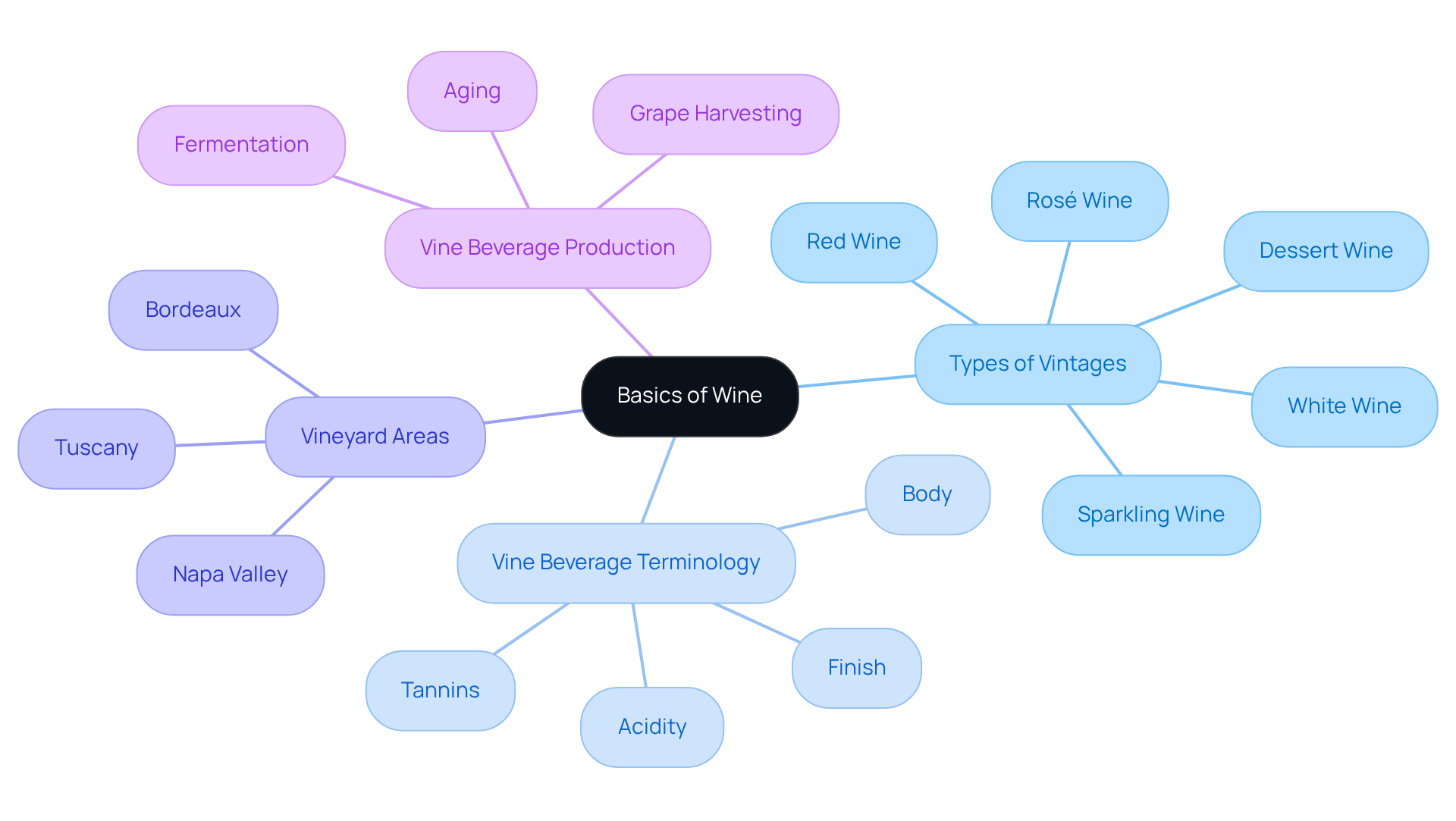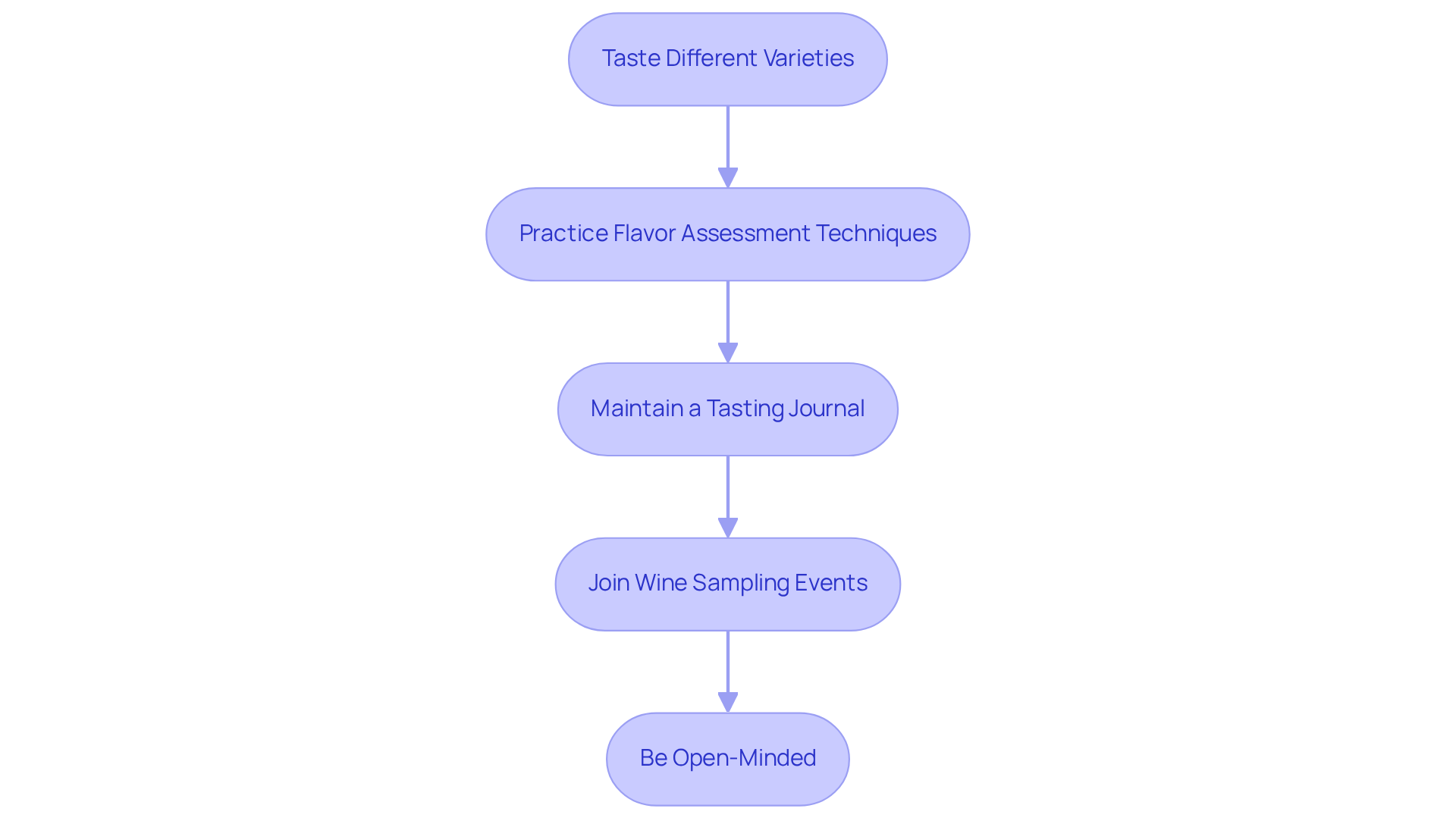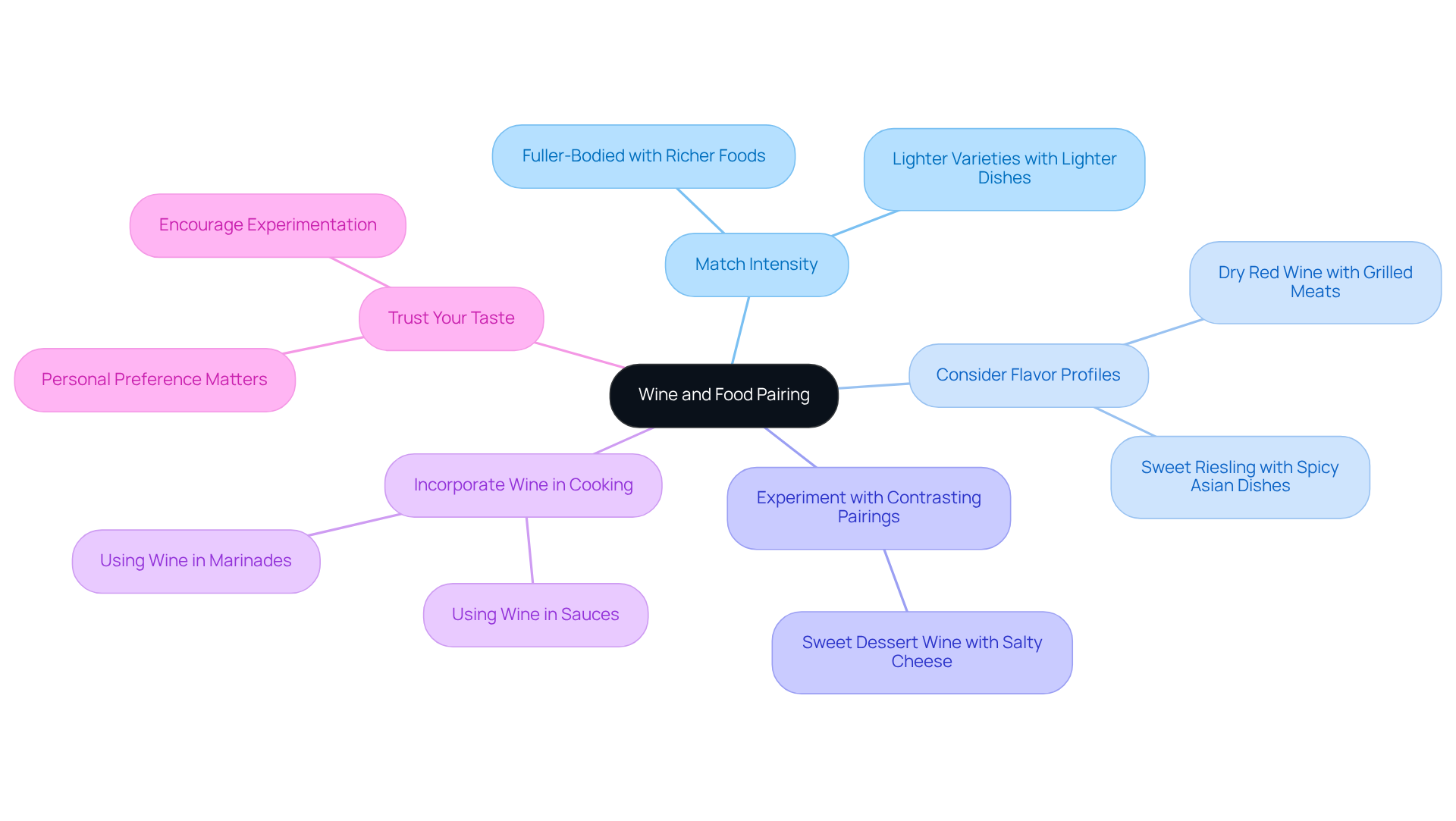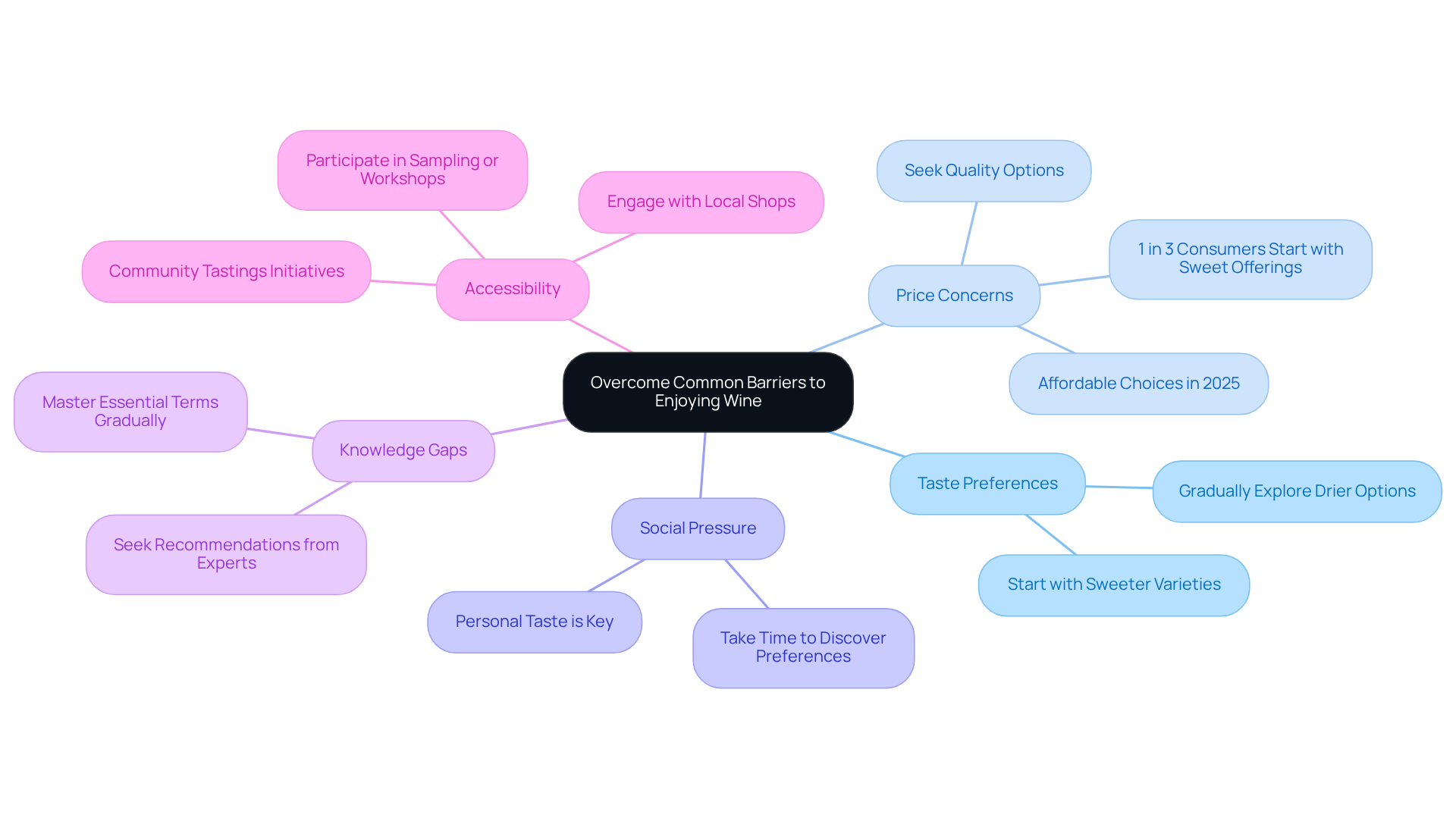Overview
To cultivate a genuine appreciation for wine, new drinkers must first familiarize themselves with the fundamentals of wine. This includes:
- Experimenting with various types
- Practicing tasting techniques to refine their palate
- Understanding wine terminology, which is crucial as it opens the door to exploring different varieties and enhances the overall enjoyment of wine
- Pairing wine with food, which can significantly elevate the experience and help overcome common barriers to appreciation
By embracing these practices, aspiring wine enthusiasts can transform their drinking experience into one of informed enjoyment.
Introduction
Embarking on the journey of wine appreciation may seem daunting for newcomers, given its intricate terminology and vast array of choices. Yet, understanding the basics of wine, developing a refined palate, and mastering the art of food pairing can transform this experience into one of enjoyment and discovery.
What if the key to unlocking the world of wine lies not merely in knowledge, but also in overcoming personal barriers and embracing individual preferences?
This guide presents essential steps for new drinkers to cultivate a genuine love for wine, encouraging exploration and enjoyment at every stage of the journey.
Understand the Basics of Wine
Embarking on your journey into the world of wine requires a solid grasp of essential concepts:
- Types of Vintages: It is crucial to understand the primary classifications: red, white, rosé, sparkling, and dessert varieties. Each type boasts unique characteristics and flavor profiles that cater to diverse palates.
- Vine Beverage Terminology: Familiarize yourself with fundamental terms such as 'tannins', 'acidity', 'body', and 'finish'. Mastering this vocabulary will significantly enhance your ability to describe and discuss various grape varieties.
- Vineyard Areas: Explore renowned vineyard regions like Bordeaux, Napa Valley, and Tuscany. Each area produces distinctive beverages shaped by its local climate and soil, contributing to the complexity of wine appreciation.
- Vine Beverage Production: Gain a comprehensive understanding of the production process, from grape harvesting to fermentation and aging. This insight enriches your appreciation of the craftsmanship behind every bottle.
By mastering these fundamentals, you will navigate beverage selections and discussions with confidence, which is essential for understanding how to learn to like wine and positioning yourself as a knowledgeable participant in the world of wine.

Develop Your Palate: Steps to Enjoy Wine
To develop your palate and enjoy wine more fully, consider the following steps:
-
Taste Different Varieties: Start by sampling a diverse range of beverages from various regions and styles. This exposure will enable you to identify your preferences. Exploring lesser-known varietals and selections from developing regions can enrich your experience, as today's consumers are increasingly adventurous in their choices.
-
Practice Flavor Assessment Techniques: Employ the 'Five S's' of beverage evaluation: See, Swirl, Sniff, Sip, and Savor. This method not only enhances your sensory experience but also aids in articulating your impressions. Research indicates that utilizing these techniques can significantly improve your tasting skills and overall enjoyment.
-
Maintain a Tasting Journal: Document your experiences with various vintages, noting flavors, aromas, and your overall impressions. This practice will assist you in tracking your preferences over time, thereby strengthening your learning and appreciation of beverages.
-
Join Wine Sampling Events: Participate in local beverage sampling sessions or classes. Engaging with knowledgeable hosts and fellow enthusiasts can deepen your understanding and enjoyment. Recent tasting events have shown a positive influence on consumer preferences, making them a valuable opportunity for connection.
-
Be Open-Minded: Do not hesitate to revisit beverages you initially disliked. As your taste evolves, you may discover a newfound appreciation for previously unappealing beverages. This adaptability is essential in a dynamic beverage landscape where preferences are continually shifting.
By actively engaging with various beverages and practicing these tasting techniques, you will refine your palate and discover how to learn to like wine, thereby enhancing your overall enjoyment. As Rob McMillan, a leading business analyst in the US beverage industry, observes, "Guests appreciate what they appreciate, regardless of food pairings," underscoring the significance of personal preference in beverage enjoyment.

Pair Wine with Food for Enhanced Enjoyment
To elevate your wine enjoyment through food pairing, consider the following essential guidelines:
- Match Intensity: Pair lighter varieties with lighter dishes—think Sauvignon Blanc with seafood—and reserve fuller-bodied selections for richer foods, such as Cabernet Sauvignon with steak.
- Consider Flavor Profiles: Seek out complementary flavors. For example, a sweet Riesling can beautifully balance the heat of spicy Asian dishes, while a dry red wine can enhance the robust flavors of grilled meats.
- Experiment with Contrasting Pairings: Embrace the delightful balance that contrasting flavors can create. Pairing a sweet dessert wine with a salty cheese can yield surprisingly enjoyable results.
- Incorporate Wine in Cooking: Enhance your culinary creations by incorporating a beverage made from fermented grapes into your cooking. Using wine in sauces or marinades can elevate the overall taste of your meal, fostering a unified dining experience.
- Trust Your Taste: Ultimately, personal preference reigns supreme. Embrace the opportunity to experiment and discover the combinations that resonate with your palate.
By mastering the principles of food and beverage pairing, you can craft exquisite dishes that highlight the finest attributes of both the food and the wine.

Overcome Common Barriers to Enjoying Wine
To enhance your enjoyment of wine and overcome common barriers, consider these effective strategies:
- Taste Preferences: If you find certain beverages too bitter or strong, begin with sweeter or lighter varieties such as Moscato or Pinot Grigio. As your palate matures, gradually explore drier options to expand your taste.
- Price Concerns: Enjoying this beverage doesn’t necessitate a hefty budget. Seek quality options from respected regions or producers that deliver excellence without the high price tag. In 2025, the average cost of affordable beverages is projected to remain accessible, facilitating the discovery of enjoyable choices for new drinkers. Notably, recent data indicates that 1 in 3 consumers enter the beverage category through a sweet offering, underscoring the importance of budget-friendly options.
- Social Pressure: Remember, beverage appreciation is inherently personal. Resist the urge to conform to others' tastes. Allow yourself the time to discover what you genuinely enjoy, whether it’s a bold red or a crisp white.
- Knowledge Gaps: If beverage terminology feels overwhelming, approach it incrementally. Focus on mastering a few essential terms and styles at a time, and don’t hesitate to seek recommendations from knowledgeable staff at local beverage shops or bars.
- Accessibility: Engage with nearby beverage shops or establishments that offer sampling or workshops. These experiences can demystify the beverage, making it more accessible and allowing you to explore various options in a relaxed environment. Successful initiatives, such as community tastings, have demonstrated effectiveness in promoting affordable beverages to consumers.
By addressing these barriers, you can cultivate a more enjoyable and fulfilling experience with this diverse beverage, which will guide you on how to learn to like wine and foster a lifelong appreciation. As wine critics often note, discovering value wines that are both enjoyable and affordable is crucial to developing a lasting relationship with wine.

Conclusion
Embarking on the journey of wine appreciation opens up a world of flavors, aromas, and experiences waiting to be explored. By mastering the fundamentals of wine, developing a discerning palate, and mastering food pairings, new drinkers can cultivate a genuine enjoyment of this diverse beverage. Each step taken in this process not only enhances the experience of drinking wine but also fosters a deeper connection with its rich culture and history.
Key insights from this guide emphasize the importance of:
- Familiarizing oneself with different types of wine
- Understanding the nuances of tasting
- Mastering the art of pairing wine with food
Engaging with a variety of vintages, practicing tasting techniques, and participating in social events can significantly elevate one’s appreciation. Furthermore, addressing personal preferences and budget concerns ensures that wine enjoyment remains accessible and enjoyable for everyone.
Ultimately, the journey to learning to appreciate wine is a personal one, filled with opportunities for exploration and discovery. Embrace the process, remain open to new experiences, and allow your palate to evolve over time. By doing so, the world of wine will not only become more enjoyable but also transform into a lifelong passion that enriches social gatherings, meals, and personal moments alike.
Frequently Asked Questions
What are the main types of wine?
The main types of wine are red, white, rosé, sparkling, and dessert varieties. Each type has unique characteristics and flavor profiles.
What important terminology should I know when learning about wine?
Important wine terminology includes 'tannins', 'acidity', 'body', and 'finish'. Understanding these terms will help you describe and discuss different grape varieties more effectively.
Which vineyard regions are notable for wine production?
Notable vineyard regions include Bordeaux, Napa Valley, and Tuscany. Each region produces unique wines influenced by its specific climate and soil.
What is the wine production process?
The wine production process involves several steps, including grape harvesting, fermentation, and aging. Understanding this process enhances your appreciation of the craftsmanship behind each bottle.
How can understanding these basics help me in the world of wine?
Mastering the basics of wine allows you to navigate beverage selections and discussions with confidence, helping you learn to appreciate wine and become a knowledgeable participant in wine-related conversations.




